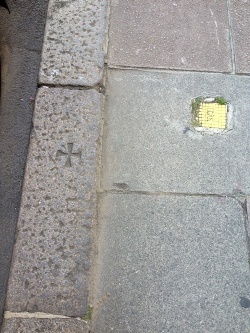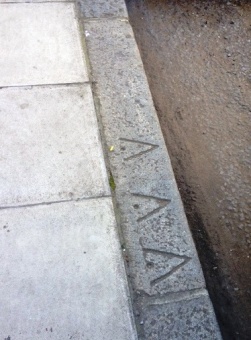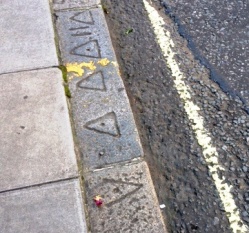Kerbstones are the very stuff of many urban geology tours. But Peter Dolan* has become captivated by their occasional enigmatic markings…
 While examining kerbstones in British towns and cities for want of anything geologically more interesting to do, you may have noticed certain marks on Victorian kerbstones. Your natural curiosity may then have led you to search the Internet to find out their meaning, and you will have found a range of views from considered and musings to supernatural invocations. You will not have found any definitive, verifiable explanation. I offer therefore the following observations drawn from my somewhat random walk through London, Saltaire (West Yorkshire), Salisbury and York.
While examining kerbstones in British towns and cities for want of anything geologically more interesting to do, you may have noticed certain marks on Victorian kerbstones. Your natural curiosity may then have led you to search the Internet to find out their meaning, and you will have found a range of views from considered and musings to supernatural invocations. You will not have found any definitive, verifiable explanation. I offer therefore the following observations drawn from my somewhat random walk through London, Saltaire (West Yorkshire), Salisbury and York.
The marks that have been noted all occur (as far as I know or can determine) on the upper surface of kerbstones, and apparently never on the vertical, road-facing face. Of course, if any marks are on the bottom or inner hidden surfaces then they are not visible without excavation. There appears to be no consistency as to whether the marks are ‘road facing’ or ‘side-walk’ facing, though the former may be more prevalent; symbols are more problematical since they often do not have a natural ‘right-way-up’. Marks occur on narrow, wide and (less commonly) on curved kerbstones, but none have been found on ‘quarter-circle’ corner kerbstones.
In London, the kerbstones themselves tend to be granitoid, sometimes with conspicuous orthoclase phenocrysts, (those in the Twickenham/Richmond area often appear to have affinities with granites of SW England), sometimes mafics (?amphibolites) or, occasionally sandstones. The distinctive SHap Granite features along Seagrave Road, near Earl’s Court Exhibition Centre. Other cities would be expected to have a similar mix, including from the early 20th Century on, an increasing admixture of Finnish and later Indian kerbstones. Smaller towns probably relied for longer on stone nearer to hand.
 The quality of marks varies tremendously, ranging from carefully chiselled Maltese crosses and letters with serifs to very poorly shaped letters ∆ shapes and so on. Letters and symbols (very rarely numerals) occur alone or in various combinations (a footnote gives a list of those I have recorded to date). When combined, they often form a set, such as LVE, HT and many others. On other occasions they can be widely spaced on the same kerbstone, apparently sending mixed messages, such as E∆ with an inverted ∆ a couple of feet away. In a broader context, clustering of marks may occur within an area: the E and ∆ just mentioned being very common in the St. Margarets (Middlesex) area – either alone or in combinations. Similarly, a batch of large crosses with a dot in each quadrant are common in the Bloomsbury (central London) area, ∆s containing dots and Maltese crosses in the Baker Street (central London) area while diamonds are a favourite in Saltaire.
The quality of marks varies tremendously, ranging from carefully chiselled Maltese crosses and letters with serifs to very poorly shaped letters ∆ shapes and so on. Letters and symbols (very rarely numerals) occur alone or in various combinations (a footnote gives a list of those I have recorded to date). When combined, they often form a set, such as LVE, HT and many others. On other occasions they can be widely spaced on the same kerbstone, apparently sending mixed messages, such as E∆ with an inverted ∆ a couple of feet away. In a broader context, clustering of marks may occur within an area: the E and ∆ just mentioned being very common in the St. Margarets (Middlesex) area – either alone or in combinations. Similarly, a batch of large crosses with a dot in each quadrant are common in the Bloomsbury (central London) area, ∆s containing dots and Maltese crosses in the Baker Street (central London) area while diamonds are a favourite in Saltaire.
Only two examples of undeniable pedigree have been found. Firstly, in Saltaire ↑ GPO (arrow and General Post Office – maybe concerned with telephone services, or the directions to the nearest post office) and ‘St. GB’ next to ‘St. GF’ marking the boundary between the parishes of St. Giles in the Fields and St. Georges Bloomsbury in Bedford Square (London). These are ‘outliers’ and not strictly part of the conundrum being considered here.
 When I began this casual project, I experienced a strong desire to prove a romantic vision of Victorian quarrymen toiling with rolled-up sleeves all day in dusty quarries; then, as the sun set on their day’s travails, they would have marked their stones with a unique symbol, indicating nothing more than pride in a job well done or, more prosaically, the amount of work accomplished and hence the pay due for their honest sweat. But I fear this does not seem to offer an explanation. Note that three examples of what look like Martini glasses with olives bobbing around in them presumably were not what our quarryman was eagerly anticipating to quench his thirst!
When I began this casual project, I experienced a strong desire to prove a romantic vision of Victorian quarrymen toiling with rolled-up sleeves all day in dusty quarries; then, as the sun set on their day’s travails, they would have marked their stones with a unique symbol, indicating nothing more than pride in a job well done or, more prosaically, the amount of work accomplished and hence the pay due for their honest sweat. But I fear this does not seem to offer an explanation. Note that three examples of what look like Martini glasses with olives bobbing around in them presumably were not what our quarryman was eagerly anticipating to quench his thirst!
On a purely ‘first principles’ basis the marks could signify one of three things:
- Pedigree: The quarryman, quarry or quarry company.
- Supply Chain: Distributing haulier, destination or customer.
- Local Information: Relating to such things as nearby or buried services, specific use of the adjoining carriageway (eg market stalls), characteristics of nearby dwellings (which brings to mind the red crosses on plague infected houses in 1665).
PEDIGREE
On an a prima facie basis it seems reasonable, since marks such as the letter E, or the symbol ∆ occur on large numbers of similar kerbstones, thereby indicating significant production volumes, perhaps from a set of quarries or a quarry company.
Confounding this assumption is the occurrence, for example, of several beautifully formed letter S marks on granitoid kerbstones at the western end of Richmond Bridge (Surrey) and similar examples of the letter S on Millstone Grit kerbstones in Saltaire (near Bradford). This strongly suggests that the marks are neither quarryman- nor quarry-specific. Arrows and arrowheads are also fairly ubiquitous, and found on different rock types.
SUPPLY CHAIN
In support of this idea is the fact that not all kerbstones bear marks (a rough estimate from those sampled is about 20%). Could a symbol represent a ‘production batch’ mark? The widespread distribution of marks might suggest a ‘common carrier’ from source to widespread points of use.
Again, there is contrary evidence. A case in point would be two ∆s widely spaced on the same kerbstone; why two? Also, in Saltaire, kerbstones carry numerous marks which would seem to be totally unnecessary for delivery, since they were sourced locally for nearby use by a single customer.
LOCAL INFORMATION
Supporting this explanation is the geographically widespread use of particular marks, like arrows or arrowheads (as previously noted), irrespective of rock type, suggesting they carry some generic meaning. Also, the presence of several marks on a single kerbstone indicates a possibly more complex message than them simply a representation of origin or author. The variable quality of marks implies to me that they were made by road-workers and, being often being rather poor, unworthy of a Victorian sett-maker. In a few instances, combination marks may lie cheek-by-jowl on the ends of abutting kerbstones suggesting to me that they were marked after laying.
In contrast to this, examples of marks being cut through a length of kerbstone has been shortened demonstrates that some marks pre-date laying. However, these could be cases of reused kerbstones, a common practice indicated by the ‘hotch potch’ of different kerbstones found in some areas.
Persuasive though these observations are that the marks relate to local circumstances, there is one fly in the ointment. This is that, in central London (and maybe other city centres), there are often long runs – several hundred yards – of uniform kerbstones with no marks. If, in such affluent areas where the local residents surely enjoyed all contemporary ‘mod cons’, no marks were used, does this suggest that they are not related to utilities and, indeed, may not be essential to the road engineer? The conundrum persists.
CONCLUSION?
I believe on balance that the marks are imparting information related to the primary site of use of host kerbstones and have nothing to do with source and/or transportation. It is tempting to say, that E, g (rare), w (rare), T, respectively stand for electricity, gas, water and telephone. But if so, what are all the ‘non-letter’ symbols, and why are there often combinations and multiples of the same symbol?
It may be that some readers are sufficiently curious to build a database of Victorian kerbstone markings (if they exist) in their own neighbourhood. If so, it is helpful to note the mark with the following information: a picture (ideally oblique including yellow parking restrictions lines or other elements for scale), location (road name, junction name, nearby house number), gross lithology, general description of kerbstone (wide, narrow, curved, etc), photographer, date.
Note, that this is not a risk-free activity. Attention to the job in hand can lead to unexpectedly painful encounters with ‘street furniture’, not to mention the local constabulary. While it is frustrating to be unable to determine the geological provenance of kerbstones reliably, taking samples for thin-section work is not advised.
Footnote
Types of kerbstone marks identified during the writing of the above article; in ‘alphabetical’ order.
↑ (various sizes and rock types), arrowhead (various), arrowhead EE, arrowhead SPB, bullet, CS, Ο, Ο enclosing +, + (various sizes, types and rock types) + with dot in each quadrant, +IIII, + E∆, ◊, ◊ bisected, ◊ with wavy ‘kite’ tail, E (various sizes, types and rock types), EHT, E↑, E∆ (∆ can be inverted), G+56, H, HT, HT∆, HTg, HV, holes (six in a row), II, IIVV, J↑, L (large with serifs), LVE, N, N (? reversed) P (various sizes and rock types), PE, PT, S (various rock types and one example being italic), SB, ? SEFA PE, SG, SW, Sw, □, □ with tail, □ with internal X, T (various types), TE, TH, ∆ (various sizes, quality and rock types, sometimes duplicated) ∆E, ∆P, ∆S, ∆ enclosing s, ∆ enclosing □, ∆∆∆II∆ with first and third ∆s containing dots, ∆II+II∆, V, VVV each with a suspended dot at open end of V, VH, X, X with dot in each quadrant.
* The author would be grateful for any constructive suggestions (although ‘get a life’ and ‘why have you stopped your medication?’ he can get anywhere). Correspondence should be directed via the Editor E: [email protected].